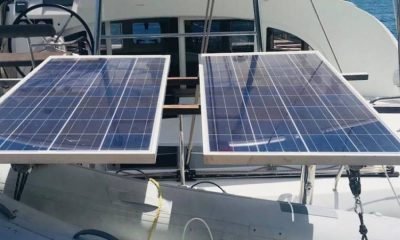Project Management
The Solar Park project is the largest single-site solar power plant in the Middle East.

Shanghai Electric Group has been appointed by ACWA Power of Saudi Arabia, as the Engineering, Construction and Procurement (EPC) contractor, to deliver the fifth phase project of the Mohammed Bin Rashid Al Maktoum Solar Park in Dubai with capacity of 900MW.
The Solar Park project is the largest single-site solar power plant in the Middle East. It comprises both photovoltaic and concentrated solar power technologies and will boast a total capacity of around 5GW once complete.
The two groups have been cooperated with each other in the 700MW Concentrated Solar Power (CSP) project and the 250MW PV solar power project, which are the fourth phase of the Solar Park. Shanghai Electric Group worked with ACWA Power for bidding the tender of the latest phase of 900MW and finally won.
Zheng Jianhua, Chairman of Shanghai Electric Group, and Muhammed Abunayyan, Chairman of ACWA Power, signed a cooperative agreement at an online signing ceremony on July 28.
“ACWA Power and Shanghai Electric are both acknowledged as important participators in the global energy field. The contract signing of 900MW Solar Park project is another milestone along the journey of the pair’s cooperation. I hope the upcoming plant will be another benchmark in the region as well as worldwide,” said Zheng at the ceremony.
Abunayyan said at the event that since the inception of the partnership in 2008, ACWA Power and Shanghai Electric Group have made quite a lot of breakthroughs, demonstrating to the world that the Group is a reliable and trusted partner. “As we move swiftly forward with implementation, the signing of the EPC contract between ACWA Power and Shanghai Electric for the fifth phase of the Solar Park project represents a crucial milestone of the cooperation between the two companies,” said Abunayyan. He added that to the latest project, the Group will bring more pioneering technologies and create larger value than before.
The Mohammed Bin Rashid Al Maktoum Solar Park will be a key pillar in fulfilling Dubai Clean Energy Strategy 2050 to increase the share of clean energy in Dubai’s total power output to 75 per cent by 2050. The project sets the benchmark for the rest of the world through leveraging the Public-Private Partnership (PPP) model and carrying forward large-scale, cost-competitive projects.
Project Management
Why wire management is important to solar project reliability, safety and life

Though wire management is often overlooked, it’s an important part of PV array installation and longevity. Proper wire management minimizes maintenance, optimizes safety and enables longer-lasting systems.
“Wiring has no standard warranties and is likely the first component of the system to have problems or fail completely. When this happens, it’s generally the solar provider’s responsibility to fix the issue,” said Andrew Wickham, marketing manager at SnapNrack. “Poor wire management could lead to service calls every couple of years, each costing hundreds of dollars.”
There are many potential issues that could arise when wires and cables aren’t secured. These components are subject to extreme temperatures and often direct sunlight, wind, snow and rain. Sharp panel and mounting system edges can score cables, and rough roof shingles can abrade insulation with continual rubbing. Rodents and other animals enjoy living under the shade of solar panels and munching on dangling wires. Such damage not only jeopardizes the system’s reliability, but also its safety.
“One underrated conversation when discussing PV system safety is wire management,” said Sarah Parsons, Wiley product manager at Burndy. “Proper wire management is vital to the health of the PV system. Damaged wire insulation can lead to ground faults, system downtime and fire.”
But these problems can be nearly eliminated with proper wire management.
What is wire management?
Wire management involves properly routing, supporting and protecting PV system wires and cables.
The only current wire management standard for the solar industry is NEC 110.12 (mechanical execution of work), which states, “Electrical equipment shall be installed in a neat and workmanlike manner.”
“This is very subjective and does not hold installers accountable to any specific work requirements,” Parsons said. “With no real industry standard for wire management, it’s difficult to police subpar installation practices and products.”
Still, wire management is about being neat and using common sense, such as ensuring wires are tucked away so rodents and other creatures don’t have access. Wires should be run in a manner that avoids damage to their insulation and conductor, avoiding sharp edges, rough surfaces, moving parts of racking systems, direct sunlight and overly tight bends.
“PV wires are not unbreakable and do have limitations when it comes to elasticity,” Parsons said. “Not observing the specified bending radius of cables can cause internal damage to the fragile copper/aluminum strands within. Not securing the wires in proper intervals puts excessive stress on connection points, the junction box and connectors, as seen in NEC 690.31 C2. Additionally, over-tightening cable ties puts pressure on wires, cutting their protective insulation.”
Wire organization and identification is another important aspect of wire management. Using wires with colored insulation is required by the NEC and helps identify circuit conductors.
“Properly organizing wiring refers to grouping, routing and labeling wires in a manner that can make for easy identification of different circuits for future maintenance and emergency personnel,” said Stuart Fox, VP of technical sales at CivicSolar, in a blog post. “Labeling strings and DC and AC circuits within junction boxes is another good practice allowing for better troubleshooting by future maintenance personnel.”
Wire management products
Proper wire support means securing wiring along PV modules and racking equipment, or in conduit trays. Accomplishing this task requires choosing appropriate components like stainless-steel wire clips, UV-stabilized composite wire clips and UV-stabilized wire ties.
Stainless steel wire clips are available in many forms to meet a variety of needs. Fox said that these clips are designed to fasten to module frames or mounting rails. They can clamp single or multiple PV wire(s), or USE-2 or TC-ER cables. Some manufacturers provide 90° clips when the clipped surface length is perpendicular to the cable route.
UV-stabilized composite cable clips, from inverter and racking companies such as Enphase, IronRidge, Unirac and SnapNrack, also attach to the mounting rail and support a variety of wire types and quantities.
When clips and cable ties are not able to provide sufficient support, Fox recommends using conduit and cable trays. Also, array-edge screens like those from SolaTrim and SnapNrack protect wiring from animals.
Using appropriately sized and listed solutions is also crucial to system longevity. Using generically-rated materials that are not UV or corrosion-resistant can lead to breakdown. Products should be listed as required by NEC 690.31 and to UL standards.
SnapNrack’s Wickham sees an industry-need for an integrated wire-management solutions.
“By integrating wire management into the solar racking system, not only are wires and cables protected from damage throughout the life of the system, but the system owner is pleased by the finished aesthetics,” he said.
The SnapNrack Series 100 and Ultra Rail pitched-roof systems provide two separate channels large enough to neatly route PV conductor wires and AC trunk lines. Junction boxes snap into rail channels without additional roof penetrations to conceal and protect electrical connections.
Utility-scale solar wire management
Utility-scale solar projects require extra consideration when it comes to wire management.
“With utility-scale projects, there is more wire, there are often more elements and, with a tracker, there is obviously a lot more movement,” said Nick Korth, product marketing manager at HellermannTyton. “With all that movement, special care must be taken to make sure the wires are safe from harm.”
To account for movement, understanding thermocycling is critical.
“Early in the morning in some parts of the country, the temperature can easily be 50° to 60° cooler than at midday,” Korth said. “The structure can move, and so too will the clips or ties. The result can range from a brittle cable tie breaking because it is not suitable for outdoor environments, to cable damage and a fault due to sharp edges on a cheap metal clip, to connectors slowly separating because they are held in place too tightly.”
Utility projects also operate at much higher voltages than residential installations.
“Today’s solar arrays are operating at voltages in excess of 1,500 V and amperages greater than 500 A,” said Roger Jette, president and founder of Snake Tray, a cable management manufacturer. “Therefore, an individual who is walking around on wet grass in a field of thousands of rails can be at risk. Installers must adhere to NEC safety procedures in such environments.”
While trenching is still an effective method for creating a physical barrier from electrical charges, Jette is seeing more systems built with increasingly sophisticated cable management. For example, his company’s Solar Snake Max cable containment system allows for code-compliant cable separation without trenching. Instead, it mounts to vertical pilings or poles.
Other considerations
Proper installation is critical when it come to the effectiveness of wire management systems.
“All wire management systems are subject to improper installation,” Korth said. “It is imperative to understand the installation crew’s capabilities and the care they will give to the smallest details of securing wire safely.”
When choosing a particular material or type of wire management component, Korth said that metal tends to be more forgiving to install but less forgiving to the cable if installed improperly.
“Plastic wire management runs the opposite, requiring more care to install but ultimately gentler on cable insulation,” he said. “Careful consideration needs to be taken when choosing plastic or metal materials.” HellermannTyton has published a white paper with more information on pros and cons of metal and plastic wire-management components.
Korth also sees wire-management standardization advancing.
“The more standardized the industry gets when it comes to these large systems, the more costs can be driven out and the fewer parts needed on the spec,” he said. “We can then standardize how wires are being routed and protected. Until then, wire management strategies will continue to change platform to platform.”
-

 Solar Panels7 years ago
Solar Panels7 years agoAre Tesla solar roof tiles worth it?
-

 Genel7 years ago
Genel7 years agoMaldives luxury resort is powered entirely by solar panels
-

 Control Systems Et Software7 years ago
Control Systems Et Software7 years agoHOMER responds to the rapidly growing solar+storage market with Grid software
-

 Solar Technologies6 years ago
Solar Technologies6 years agoGOODWE PARTNERSHIP WITH GE
-

 Solar Technologies5 years ago
Solar Technologies5 years agoSolar panel covered Autobahn can break speed record for Germany’s energy transition
-

 Operation and Maintenance7 years ago
Operation and Maintenance7 years ago1000-Acre Sunflower Solar Farm to be Built for Entergy Mississippi
-

 Events6 years ago
Events6 years agoGREENoneTEC revolutionizes solar heating with Sunpad
-

 Large -Scale Solar Panels7 years ago
Large -Scale Solar Panels7 years agoABB to construct solar power expansion in Dubai


